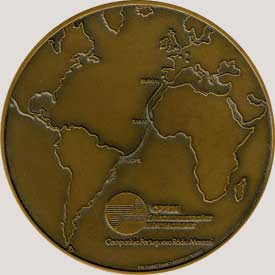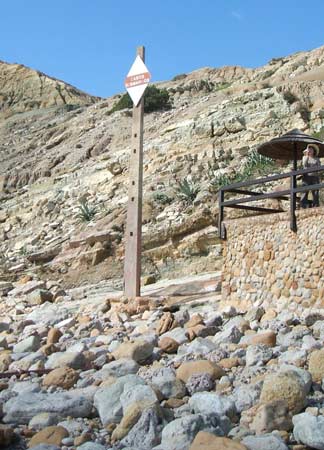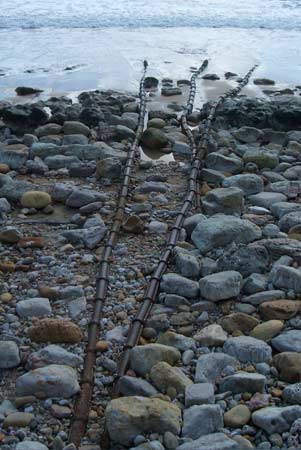In the early 1980s, Burgau, a fishing village in the Algarve region of Portugal now mostly known for tourism, became the landing the site of two cables.
In 1982 Section 2 of the ATLANTIS cable was laid from Dakar, Senegal to Burgau, the complete route being Brazil-Senegal-Portugal. The cable was made by Câbles de Lyon; Alcatel manufactured the repeaters. Laid by CS Vercors for CPRM/Embratel, the system length was 1570 nm and the cable provided 2580 x 4 kHz channels. This section of the cable was commemorated by a medal, the reverse showing a map of the route:

Cabo Submarino Atlantis 1982
Medal diameter 80mm
Bronze
|

CPRM telecomuniçacöes internaciones
CompanhiaPortuguesaRádioMarconi
Esc[ultura] Soares Branco
Med89.GR.Medaglis |
In 1983 ATLAS was laid from Burgau to Arzila/Asilah, Morocco, also by CS Vercors. The cable was made by Câbles de Lyon for CPRM - MATELCA; system length was 193 nm. and the cable provided 1260 x 4kHz channels. This cable also had a commemorative meda; in this case the obverse shows the routel.
ATLAS was withdrawn from service in 1999.

Cabo Submarino Portugal Marrocos
Burgau - Asilah
Medal diameter 80mm
Bronze
|

Sistema Atlas 1983
CPRM telecomuniçacöes internaciones
CompanhiaPortuguesaRádioMarconi |
| Atlas medal images courtesy of eBay seller Bargainblasters |
While the cables are no longer in service, a sign on the beach at Burgau warns passing ships of their location, and three cables may be seen running down into the water.

“Cabos Submarinos”
Detail of sign |

Shore end cables, protected by
cast-iron articulated pipe |
The cables are enclosed at the shore by an outer casing of interlocking cast-iron cylinders of about 6" diameter, known in the cable industry as “Articulated Pipe.” This type of additional protection may be seen at about 13 minutes into the film on the 1964 laying of the Hawaii-Japan cable, TPC-1, on the CS Long Lines page, where it was used to protect the shore end from coral at Midway Island.
Stewart Ash provides these notes on articulated pipe:
Articulated pipe is not applied, as most people think, to provide additional impact protection. Cast iron is quite brittle and can shatter when hit hard, and if this were to happen the shattered pieces would create a greater risk to the cable. Articulated pipe is actually used to provide additional mass to the cable, in order to stabilize it in shallow water at landings where there is high surf, strong currents, and/or mobile seabeds (sand, fine silt).
It generally runs out to sea from the beach manhole, and is applied to the shore-end cable out to water depths of no more than 20m; then, where possible, it is buried. In some locations, the protected cable can be pinned to a rock seabed and around reefs or tropical seabeds. Articulated pipe also attracts marine growth better than armoured cable, so can be considered beneficial from an environmental perspective.
Where shore-end cables have articulated pipe applied, the enclosed -cable is always double-armour shore end type; it is very rare for the pipe to be applied to single armour cable. There is no industry standard for articulated pipe, as each cable manufacturer tends to use their own design, so it can come in varying shapes, lengths and mass, with a range of fixing techniques, although it always comes as two halves split longitudinally. Nuts and bolts are the most common form of fixing the two halves. Usually, a contract will include spare sections of pipe as part of the system maintenance spares, and these are held at the local depot or the cable station.
In his 1996 article on the FLAG cable system, Mother Earth Mother Board, Neal Stephenson also remarks on articulated pipe:
Shallow water is the most perilous part of a cable’s route. Extra precautions must be taken in the transition from deep water to the beach, and these precautions get more extreme as the water gets more shallow. Between 1,000 and 3,000 meters, the cable has a single layer of armor wires (steel rods about as thick as a pencil) around it. In less than 1,000 meters of water, it has a second layer of armor around the first. In the final approach to the shoreline, this double-armored cable is contained within a massive shell of articulated cast-iron pipe, which in turn is buried under up to a meter of sand.
The articulated pipe comes in sections half a meter long, which have to be manually fit around the cable and bolted together. Each section of pipe interlocks with the ones on either end of it. The coupling is designed to bend a certain amount so that the cable can be snaked around any obstructions to its destination: the beach manhole. It will bend only so much, however, so that the cable’s minimum radius of curvature will not be violated.

Detail of articulated pipe sections |
Burgau photographs courtesy of and copyright © 2010 Bob Rogers, by whose kind permission they appear here. |

